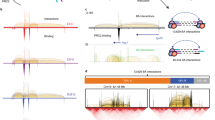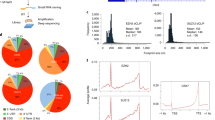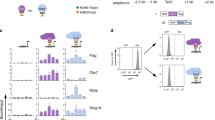Abstract
The Polycomb repressive complex 2 (PRC2) mainly mediates transcriptional repression1,2 and has essential roles in various biological processes including the maintenance of cell identity and proper differentiation. Polycomb-like (PCL) proteins, such as PHF1, MTF2 and PHF19, are PRC2-associated factors that form sub-complexes with PRC2 core components3, and have been proposed to modulate the enzymatic activity of PRC2 or the recruitment of PRC2 to specific genomic loci4,5,6,7,8,9,10,11,12,13. Mammalian PRC2-binding sites are enriched in CG content, which correlates with CpG islands that display a low level of DNA methylation14. However, the mechanism of PRC2 recruitment to CpG islands is not fully understood. Here we solve the crystal structures of the N-terminal domains of PHF1 and MTF2 with bound CpG-containing DNAs in the presence of H3K36me3-containing histone peptides. We show that the extended homologous regions of both proteins fold into a winged-helix structure, which specifically binds to the unmethylated CpG motif but in a completely different manner from the canonical winged-helix DNA recognition motif. We also show that the PCL extended homologous domains are required for efficient recruitment of PRC2 to CpG island-containing promoters in mouse embryonic stem cells. Our research provides the first, to our knowledge, direct evidence to demonstrate that PCL proteins are crucial for PRC2 recruitment to CpG islands, and further clarifies the roles of these proteins in transcriptional regulation in vivo.
This is a preview of subscription content, access via your institution
Access options
Access Nature and 54 other Nature Portfolio journals
Get Nature+, our best-value online-access subscription
$29.99 / 30 days
cancel any time
Subscribe to this journal
Receive 51 print issues and online access
$199.00 per year
only $3.90 per issue
Buy this article
- Purchase on Springer Link
- Instant access to full article PDF
Prices may be subject to local taxes which are calculated during checkout




Similar content being viewed by others
References
Comet, I., Riising, E. M., Leblanc, B. & Helin, K. Maintaining cell identity: PRC2-mediated regulation of transcription and cancer. Nat. Rev. Cancer 16, 803–810 (2016)
Margueron, R. & Reinberg, D. The Polycomb complex PRC2 and its mark in life. Nature 469, 343–349 (2011)
Hauri, S. et al. A high-density map for navigating the human Polycomb complexome. Cell Reports 17, 583–595 (2016)
Ballaré, C. et al. Phf19 links methylated Lys36 of histone H3 to regulation of Polycomb activity. Nat. Struct. Mol. Biol. 19, 1257–1265 (2012)
Boulay, G., Rosnoblet, C., Guérardel, C., Angrand, P. O. & Leprince, D. Functional characterization of human Polycomb-like 3 isoforms identifies them as components of distinct EZH2 protein complexes. Biochem. J. 434, 333–342 (2011)
Brien, G. L. et al. Polycomb PHF19 binds H3K36me3 and recruits PRC2 and demethylase NO66 to embryonic stem cell genes during differentiation. Nat. Struct. Mol. Biol. 19, 1273–1281 (2012)
Cai, L. et al. An H3K36 methylation-engaging Tudor motif of polycomb-like proteins mediates PRC2 complex targeting. Mol. Cell 49, 571–582 (2013)
Cao, R. et al. Role of hPHF1 in H3K27 methylation and Hox gene silencing. Mol. Cell. Biol. 28, 1862–1872 (2008)
Casanova, M. et al. Polycomblike 2 facilitates the recruitment of PRC2 Polycomb group complexes to the inactive X chromosome and to target loci in embryonic stem cells. Development 138, 1471–1482 (2011)
Hunkapiller, J. et al. Polycomb-like 3 promotes polycomb repressive complex 2 binding to CpG islands and embryonic stem cell self-renewal. PLoS Genet. 8, e1002576 (2012)
Musselman, C. A. et al. Molecular basis for H3K36me3 recognition by the Tudor domain of PHF1. Nat. Struct. Mol. Biol. 19, 1266–1272 (2012)
Walker, E. et al. Polycomb-like 2 associates with PRC2 and regulates transcriptional networks during mouse embryonic stem cell self-renewal and differentiation. Cell Stem Cell 6, 153–166 (2010)
Sarma, K., Margueron, R., Ivanov, A., Pirrotta, V. & Reinberg, D. Ezh2 requires PHF1 to efficiently catalyze H3 lysine 27 trimethylation in vivo. Mol. Cell. Biol. 28, 2718–2731 (2008)
Ku, M. et al. Genomewide analysis of PRC1 and PRC2 occupancy identifies two classes of bivalent domains. PLoS Genet. 4, e1000242 (2008)
Kycia, I. et al. The Tudor domain of the PHD finger protein 1 is a dual reader of lysine trimethylation at lysine 36 of histone H3 and lysine 27 of histone variant H3t. J. Mol. Biol. 426, 1651–1660 (2014)
Qin, S. et al. Tudor domains of the PRC2 components PHF1 and PHF19 selectively bind to histone H3K36me3. Biochem. Biophys. Res. Commun. 430, 547–553 (2013)
Holm, L. & Rosenström, P. Dali server: conservation mapping in 3D. Nucleic Acids Res. 38, W545–9 (2010)
Callebaut, I. & Mornon, J. P. The PWAPA cassette: Intimate association of a PHD-like finger and a winged-helix domain in proteins included in histone-modifying complexes. Biochimie 94, 2006–2012 (2012)
Clark, K. L., Halay, E. D., Lai, E. & Burley, S. K. Co-crystal structure of the HNF-3/fork head DNA-recognition motif resembles histone H5. Nature 364, 412–420 (1993)
Biggs, W. H., III, Cavenee, W. K. & Arden, K. C. Identification and characterization of members of the FKHR (FOX O) subclass of winged-helix transcription factors in the mouse. Mamm. Genome 12, 416–425 (2001)
Jones, P. A. Functions of DNA methylation: islands, start sites, gene bodies and beyond. Nat. Rev. Genet. 13, 484–492 (2012)
Gajiwala, K. S. et al. Structure of the winged-helix protein hRFX1 reveals a new mode of DNA binding. Nature 403, 916–921 (2000)
Berger, M. F. et al. Compact, universal DNA microarrays to comprehensively determine transcription-factor binding site specificities. Nat. Biotechnol. 24, 1429–1435 (2006)
Li, X. et al. Mammalian polycomb-like Pcl2/Mtf2 is a novel regulatory component of PRC2 that can differentially modulate polycomb activity both at the Hox gene cluster and at Cdkn2a genes. Mol. Cell. Biol. 31, 351–364 (2011)
Kloet, S. L. et al. The dynamic interactome and genomic targets of Polycomb complexes during stem-cell differentiation. Nat. Struct. Mol. Biol. 23, 682–690 (2016)
Voo, K. S., Carlone, D. L., Jacobsen, B. M., Flodin, A. & Skalnik, D. G. Cloning of a mammalian transcriptional activator that binds unmethylated CpG motifs and shares a CXXC domain with DNA methyltransferase, human trithorax, and methyl-CpG binding domain protein 1. Mol. Cell. Biol. 20, 2108–2121 (2000)
Xu, C., Bian, C., Lam, R., Dong, A. & Min, J. The structural basis for selective binding of non-methylated CpG islands by the CFP1 CXXC domain. Nat. Commun. 2, 227 (2011)
Berger, M. F. & Bulyk, M. L. Universal protein-binding microarrays for the comprehensive characterization of the DNA-binding specificities of transcription factors. Nat. Protocols 4, 393–411 (2009)
Xiao, S. et al. Comparative epigenomic annotation of regulatory DNA. Cell 149, 1381–1392 (2012)
Adams, P. D . et al. PHENIX: a comprehensive Python-based system for macromolecular structure solution. Acta Crystallogr. D 66, 213–221 (2010)
Langer, G., Cohen, S. X., Lamzin, V. S. & Perrakis, A. Automated macromolecular model building for X-ray crystallography using ARP/wARP version 7. Nat. Protocols 3, 1171–1179 (2008)
Emsley, P., Lohkamp, B., Scott, W. G. & Cowtan, K. Features and development of Coot. Acta Crystallogr. D 66, 486–501 (2010)
Sanjana, N. E., Shalem, O. & Zhang, F. Improved vectors and genome-wide libraries for CRISPR screening. Nat. Methods 11, 783–784 (2014)
Liefke, R., Karwacki-Neisius, V. & Shi, Y. EPOP interacts with Elongin BC and USP7 to modulate the chromatin landscape. Mol. Cell 64, 659–672 (2016)
Kalb, R. et al. Histone H2A monoubiquitination promotes histone H3 methylation in Polycomb repression. Nat. Struct. Mol. Biol. 21, 569–571 (2014)
Trapnell, C. et al. Differential gene and transcript expression analysis of RNA-seq experiments with TopHat and Cufflinks. Nat. Protocols 7, 562–578 (2012)
Langmead, B., Trapnell, C., Pop, M. & Salzberg, S. L. Ultrafast and memory-efficient alignment of short DNA sequences to the human genome. Genome Biol. 10, R25 (2009)
Ramírez, F., Dündar, F., Diehl, S., Grüning, B. A. & Manke, T. deepTools: a flexible platform for exploring deep-sequencing data. Nucleic Acids Res. 42, W187–W191 (2014)
Liu, T. et al. Cistrome: an integrative platform for transcriptional regulation studies. Genome Biol. 12, R83 (2011)
Gentleman, R. C. et al. Bioconductor: open software development for computational biology and bioinformatics. Genome Biol. 5, R80 (2004)
Bailey, T. L. et al. MEME SUITE: tools for motif discovery and searching. Nucleic Acids Res. 37, W202–W208 (2009)
Acknowledgements
We thank the staff from the BL17U1, BL18U1 and BL19U1 beamlines of National Facility for Protein Science in Shanghai (NFPS) at Shanghai Synchrotron Radiation Facility (SSRF) in China for assistance during data collection, and C. Yun for help in data collection in the United States. We thank G. Jiang for help with ITC studies. We thank A. Jambhekar for critical reading of the manuscript. This work was supported by the National Natural Science Foundation of China (31370719 and 31570729), Beijing Natural Science Foundation (5152015) and the Fundamental Research Funds for the Central Universities (2014KJJCA09 and 2017EYT19) to Z.W. Early research on PCL protein expression undertaken by Z.W. in the laboratory of D.J.P. was supported by the Leukemia and Lymphoma Society and by the Memorial Sloan-Kettering Cancer Center Core Grant (P30 CA008748). Research on PCL proteins was supported by the German Research Foundation (DFG, LI 2057/1-1) to R.L, NIH/NHGRI R01 grant HG003985 to M.L.B., and the National Cancer Institute (R01 CA118487) and funds from Boston Children’s Hospital to Y.S. Y.S. is an American Cancer Society Research Professor.
Author information
Authors and Affiliations
Contributions
H.L. performed the protein expression, purification and the crystallographic studies. R.L. performed experiments in mouse ES cells, genome-wide analyses and MTF2 complex experiments. J.J. did the ITC and EMSA assays. J.V.K. performed protein binding microarray experiments. W.T., P.D., W.Z. and Q.H. assisted in cloning and protein purification. M.L.B. supervised the protein binding microarray research. All authors analysed the data. Z.W. initialized the project, determined the crystal structures, designed the experiments with R.L. and Y.S., and wrote the paper with the help of R.L., D.J.P., J.V.K., M.L.B. and Y.S.
Corresponding author
Ethics declarations
Competing interests
Y.S. is a co-founder of Constellation Pharmaceuticals and a member of its scientific advisory board, and a consultant for Active Motif, Inc. The remaining authors declare no competing financial interests.
Additional information
Reviewer Information Nature thanks L. Chen, L. Di Croce and R. Klose for their contribution to the peer review of this work.
Publisher's note: Springer Nature remains neutral with regard to jurisdictional claims in published maps and institutional affiliations.
Extended data figures and tables
Extended Data Figure 1 Sequence alignment of human PCL proteins, or the EH/WH regions from various species.
a, Sequence alignment of the N-terminal domains of human PCL proteins. Residues with high similarity are coloured in red. Key residues mentioned in the text are highlighted yellow and indicated with blue triangles at the bottom. b, Sequence alignment of the EH domains from various species of PCL proteins and two typical winged-helix motifs. Conserved IKK(K/R)K motifs within the W1 loop of various PCL proteins are indicated in a blue box. Species abbreviations: h, Homo sapiens; m, Mus musculus; dr, Danio rerio; xl, Xenopus laevis; dm, Drosophila melanogaster.
Extended Data Figure 2 Binding analysis of PCL proteins with different CpG-motif substitutions or with CpG-containing DNAs varying in their flanking sequences.
a, EMSA results of the PHF1(26–360) fragment with different DNA duplexes bearing base substitutions in the CpG motif. b, c, EMSA results of PHF1(165–360) (b) or MTF2(180–378) (c) with various NCpGN-containing DNA motifs; N denotes any DNA base. The protein-to-DNA molar ratio is shown at the top. Data are representative of at least three independent experiments. Uncropped gels are shown in Supplementary Fig. 1.
Extended Data Figure 3 Comparisons of DNA-bound PHF1 or MTF2 EH domains with two DNA-bound winged-helix motifs and a CXXC domain.
a, Electrostatic surface of the PHF1 cassette, with basic regions shown in blue and acidic regions in red. Bound DNA is shown in a cartoon representation. b, Superimposition of the PHF1-bound DNA (coloured in orange) with a canonical B-form DNA (coloured in blue; PDB code 1HQ7). c–e, Comparison of the DNA-recognizing details of the PHF1 EH domain (c) with the winged-helix motifs of HNF-3γ (d; PDB code 1VTN) and hRFX1 (e; PDB code 1DP7) when all three domains were structurally aligned. f–h, Comparison of the CpG-recognition details of the MTF2 EH domain (f) and the PHF1 EH domain (g) with that of the CFP1 CXXC (h; PDB code 3QMC). Of note, both cytosine residues of the CpG duplex form hydrogen bonds with the main-chain carbonyl oxygens, while both guanines of the CpG duplex were also recognized by forming hydrogen bonds with the side chains.
Extended Data Figure 4 Creation of MTF2-knockout mouse ES cells and qPCR experiments.
a, Representative western blot of endogenous MTF2 in mouse ES cells. Three distinct isoforms are indicated. b, Schematic overview of the three MTF2 isoforms and their corresponding translational start sites. Positions of four test CRISPR gRNA targets are shown. c, Western blot of mouse ES cells expressing a control of CRISPR construct or CRISPR constructs targeting the Mtf2 gene as depicted in b. CRISPR 4 (in red) was used to obtain single cell clones. d, Sequence validation of two single cell clones. e, Western blotting of nucleoplasm and chromatin fractions from two MTF2-knockout clones and control cells. Data are representative of two independent experiments. f, g, RT–qPCR of control cells and two MTF2-knockout clones (f) or control, knockout, or MTF2-knockout cells rescued with wild-type or MTF2(Lys339Ala) (g). Data are mean ± s.d. of three biological replicates. h, ChIP–qPCR experiments in control, MTF2-knockout, and rescued cells with the antibodies shown. Data are mean ± s.d. of two biological replicates. Uncropped blots are shown in Supplementary Fig. 1.
Extended Data Figure 5 Analysis of the ChIP–seq experiments and PHF19-knockdown ChIP–seq data.
a, Comparison of normalized ChIP–seq promoter reads (as in Fig. 4f) of three biological replicates for MTF2, SUZ12 and H3K27me3. The whisker-box plots represent the lower quartile, median and upper quartile of the data with 5% and 95% whiskers. b, Comparison of MTF2 ChIP–seq data in control and MTF2-knockout cells (replicate 3) at the three promoter groups described in Fig. 4a. c, Promoter profiles of SUZ12 and H3K27me3 in control and PHF19-knockdown cells using publically available data10.
Extended Data Figure 6 EMSA and HMTase experiments with purified MTF2–PRC2 complex.
a, Silver staining of purified wild-type or Lys339Ala mutant human MTF2–PRC2 complexes (and mock control) from HeLa-S cells. F/H, Flag–HA-tagged. b, Western blotting of the eluates from a. c, EMSA experiment with equal volumes (0, 0.5, 1, 2, 3 μl) of the eluates using the 12-mer-CpG sequence. Data are representative of two independent experiments. d, Histone methyltransferase (HMTase) experiment using equal volumes (15 μl) of the eluates from a. Two technical replicates are shown. H3K27me3 levels were investigated by western blotting. Uncropped blots are shown in Supplementary Fig. 1.
Supplementary information
Supplementary Figures
This file contains Supplementary Figure 1: uncropped blot and EMSA images. (PDF 4734 kb)
Rights and permissions
About this article
Cite this article
Li, H., Liefke, R., Jiang, J. et al. Polycomb-like proteins link the PRC2 complex to CpG islands. Nature 549, 287–291 (2017). https://doi.org/10.1038/nature23881
Received:
Accepted:
Published:
Issue Date:
DOI: https://doi.org/10.1038/nature23881
This article is cited by
-
Polycomb repressive complex 2 and its core component EZH2: potential targeted therapeutic strategies for head and neck squamous cell carcinoma
Clinical Epigenetics (2024)
-
Synthetic reversed sequences reveal default genomic states
Nature (2024)
-
Pharmacological inhibition of EZH2 using a covalent inhibitor suppresses human ovarian cancer cell migration and invasion
Molecular and Cellular Biochemistry (2024)
-
Regulation, functions and transmission of bivalent chromatin during mammalian development
Nature Reviews Molecular Cell Biology (2023)
-
Loss of cohesin regulator PDS5A reveals repressive role of Polycomb loops
Nature Communications (2023)
Comments
By submitting a comment you agree to abide by our Terms and Community Guidelines. If you find something abusive or that does not comply with our terms or guidelines please flag it as inappropriate.



